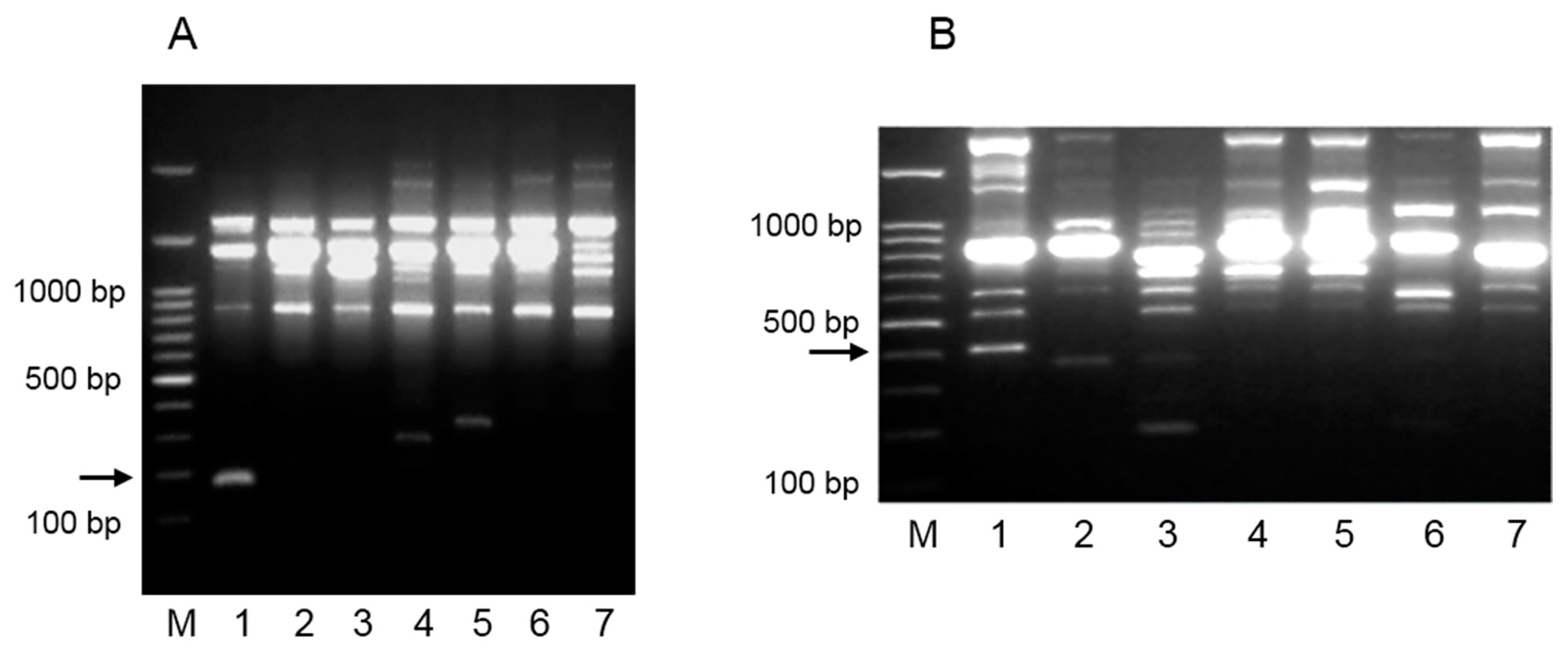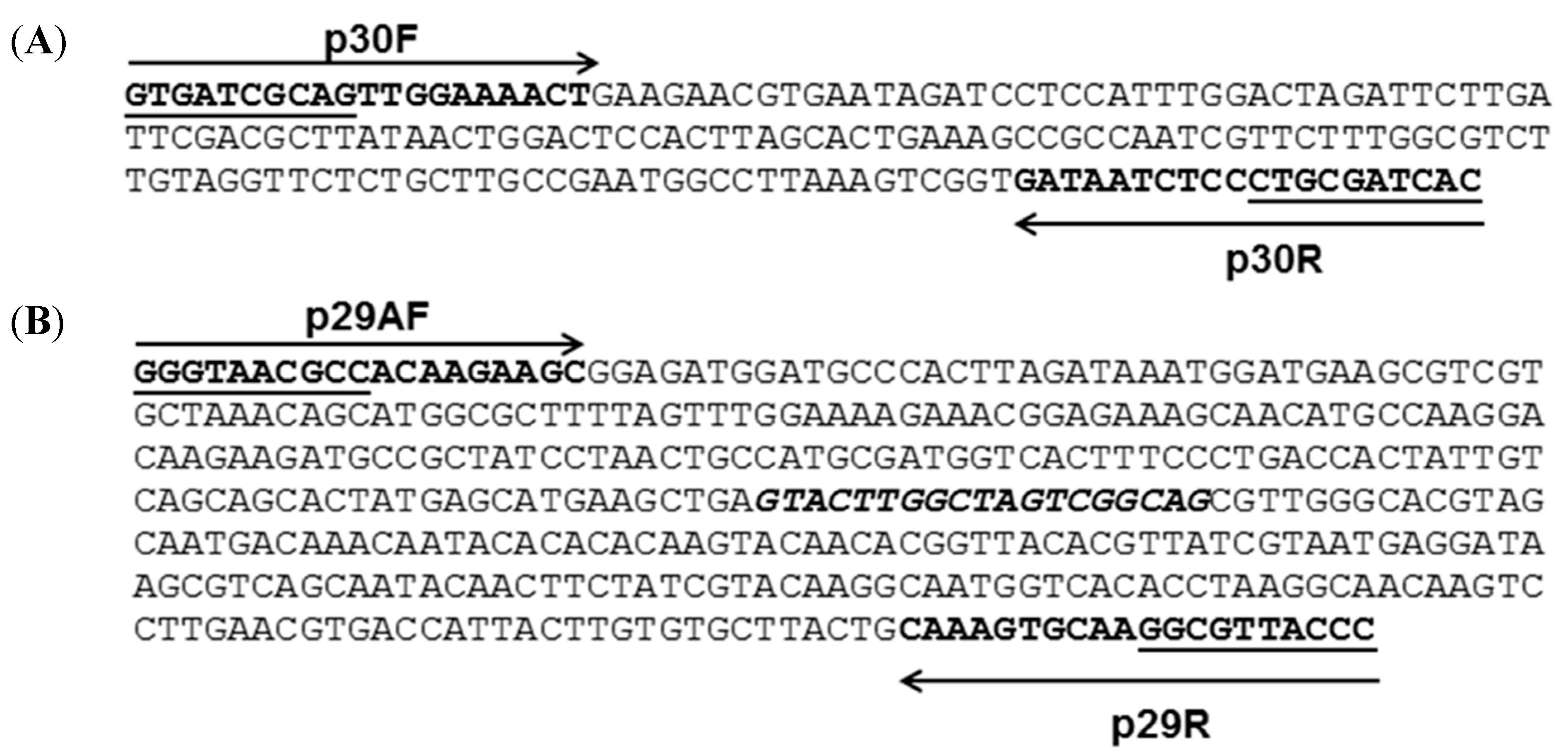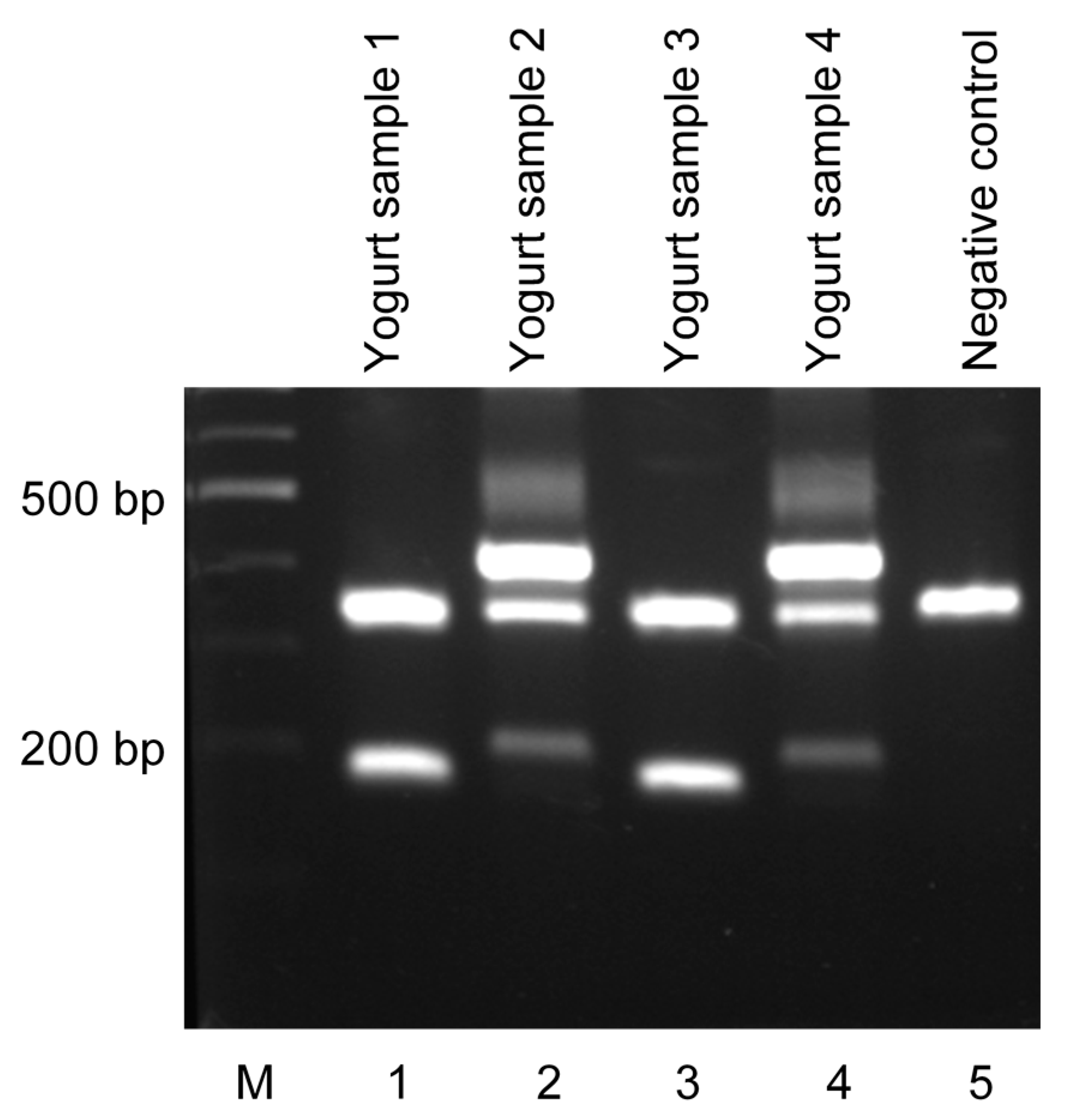Detection and Identification of Probiotic Lactobacillus plantarum Strains by Multiplex PCR Using RAPD-Derived Primers
Abstract
:1. Introduction
2. Results and Discussion
2.1. Screening of RAPD Primers and Isolation of SCAR Markers

2.2. RAPD-Derived Primers for L. plantarum 2035 and L. plantarum ACA-DC 2640

| Reference Strain | Specificity of Primer Pairs | |||
|---|---|---|---|---|
| p30F/p30R (179 bp) | p29AF/p29R (401 bp) | p29BF/p29R (200 bp) | Lac1F/Lac1R (340 bp) | |
| L. plantarum 2035 | + | − | − | + |
| L. plantarum ACA-DC 2640 | − | + | + | + |
2.3. Multiplex PCR with RAPD-Derived Strain Specific Primers

| Strain Tested | 2-Band Pattern | 3-Band Pattern |
|---|---|---|
| Lactobacillus plantarum 2035 | + | − |
| L. plantarum ACA-DC 2640 | − | + |
| L. plantarum E1 | − | − |
| L. plantarum E4 | − | − |
| L. plantarum E45 | − | − |
| L. plantarum E50 | − | − |
| L. plantarum E66 | − | − |
| L. plantarum E68 | − | − |
| L. plantarum E71 | − | − |
| L. plantarum E73 | − | − |
| L. plantarum E77 | − | − |
| L. plantarum E79 | − | − |
| L. plantarum E10 | − | − |
| L. plantarum E69 | − | − |
| L. plantarum E282 | − | − |
| L. plantarum E63 | − | − |
| L. plantarum E146 | − | − |
| L. plantarum E287 | − | − |
| L. pentosus Ε110 | − | − |
| L. pentosus 281 | − | − |
| L. casei Shirota ACA-DC 6002 | − | − |
| L. casei ATCC 393 | − | − |
| L. rhamnosus GG ATCC 53103 | − | − |
| L. delbrueckii subsp. bulgaricus | − | − |

3. Experimental Section
3.1. Bacterial Strains and Culture Conditions
3.2. DNA Extraction from Pure Cultures
3.3. Yogurt Production
3.4. Microbial Enumeration
3.5. DNA Extraction from Yogurt Samples
3.6. RAPD PCR
3.7. Cloning and Sequencing
3.8. Multiplex PCR
4. Conclusions
Acknowledgments
Author Contributions
Conflicts of Interest
References
- FAO/WHO. Guidelines for the Evaluation of Probiotics in Food; Food and Agriculture Organization (FAO), World Health Organization (WHO): Geneva, Switzerland, 2002. [Google Scholar]
- Granato, D.; Branco, G.; Gomes Cruz, A.; de Assis Fonseca Faria, J.; Shah, N. Probiotic dairy products as functional foods. Compr. Rev. Food. Sci. Food. Saf. 2010, 9, 455–470. [Google Scholar] [CrossRef]
- BCC Research. Market forecasting, the probiotics market: Ingredients, supplements, foods. June, 2011. Available online: http://www.bccresearch.com/market-research/food-and-beverage/probiotics-market-ingredients-foods-fod035c.html (accessed on 1 June 2011).
- Aureli, P.; Capurso, L.; Castellazzi, A.M.; Clerici, M.; Giovannini, M.; Morelli, L.; Poli, A.; Pregliasco, F.; Salvini, F.; Zuccotti, G.V. Probiotics and health: An evidence-based review. Pharm. Res. 2011, 63, 366–376. [Google Scholar] [CrossRef] [PubMed]
- Guyonnet, D.; Chassany, O.; Ducrotte, P.; Picard, C.; Mouret, M.; Mercier, C.H. Effect of a fermented milk containing Bifidobacterium animalis DN-173 010 on the health-related quality of life and symptoms in irritable bowel syndrome in adults in primary care: A multicentre, randomized, double-blind, controlled trial. Aliment. Pharmacol. Ther. 2007, 26, 475–486. [Google Scholar] [CrossRef] [PubMed]
- Deshpande, G.; Rao, S.; Patole, S.; Bulsara, M. Updated meta-analysis of probiotics for preventing necrotizing enterocolitis in preterm neonates. Pediatrics 2010, 125, 921–930. [Google Scholar] [CrossRef] [PubMed]
- Zocco, M.A.; dal Verme, L.Z.; Cremonini, F.; Piscaglia, A.C.; Nista, E.C.; Candelli, M.; Novi, M.; Rigante, D.; Cazzato, I.A.; Ojetti, V.; et al. Efficacy of Lactobacillus GG in maintaining remission of ulcerative colitis. Aliment. Pharmacol. Ther. 2006, 23, 1567–1574. [Google Scholar] [CrossRef] [PubMed]
- Kumar, P.; Poddar, D.; Aggarwal, P.K.; Henry, C.J.; Jain, S.; Yadav, H. Cancer-preventing attributes of probiotics: An update. Int. J. Food Sci. Nutr. 2010, 61, 473–496. [Google Scholar] [CrossRef] [PubMed]
- Park, D.Y.; Ahn, Y.T.; Park, S.H.; Huh, C.S.; Yoo, S.R.; Yu, R.; Sung, M.K.; McGregor, R.; Choi, M.S. Supplementation of Lactobacillus curvatus HY7601 and Lactobacillus plantarum KY1032 in diet-induced obese mice is associated with gut microbial changes and reduction in obesity. PLoS ONE 2013, 8, e594702013. [Google Scholar]
- Bravo, J.A.; Forsythe, P.; Chew, M.V.; Escaravage, E.; Savignac, H.M.; Dinan, T.G. Ingestion of Lactobacillus strain regulates emotional behavior and central GABA receptor expression in a mouse via the vagus nerve. Proc. Natl. Acad. Sci. USA 2011, 108, 16050–16055. [Google Scholar] [PubMed]
- Tzanetakis, N.; Litopoulou-Tzanetaki, E. Changes in numbers and kinds of lactic acid bacteria in Feta and Teleme, two Greek cheeses from ewes’ milk. J. Dairy Sci. 1992, 75, 1389–1393. [Google Scholar]
- Zoumpopoulou, G.; Alexandraki, V.; Kazou, M.; Papadelli, M.; Tzouvanou, A.; Manolopoulou, E.; Anastasiou, R.; Georgalaki, M.; Mavrogonatou, E.; Kletsas, D.; Papadimitriou, K.; Tsakalidou, E. Greek traditional dairy and meat products: A biological reservoir for new probiotic strains. In Proceedings of the 6th Congress of European Microbiologists, Maastricht, The Netherlands, 7–11 June 2015; p. 291.
- Kotzamanidis, C.; Kourelis, A.; Litopoulou-Tzanetaki, E.; Tzanetakis, N.; Yiangou, M. Evaluation of adhesion capacity, cell surface traits and immunomodulatory activity of presumptive probiotic Lactobacillus strains. Int. J. Food Microbiol. 2010, 140, 154–163. [Google Scholar] [PubMed]
- Xanthopoulos, V.; Hatzikamari, M.; Adamidis, T.; Tsakalidou, E.; Tzanetakis, N.; Litopoulou-Tzanetaki, E. Heterogeneity of Lactobacillus plantarum isolates from Feta cheese throughout ripening. J. Appl. Microbiol. 2000, 88, 1056–1064. [Google Scholar] [PubMed]
- Xanthopoulos, V.; Litopoulou-Tzanetaki, E.; Tzanetakis, N. Characterization of Lactobacillus isolates from infant faeces as dietary adjuncts. Food Microbiol. 2000, 17, 205–215. [Google Scholar] [CrossRef]
- Mohania, D.; Nagpal, R.; Kumar, M.; Bhardwaj, A.; Yadav, M.; Jain, S.; Marotta, F.; Singh, V.; Parkash, O.; Yadav, H. Molecular approaches for identification and characterization of lactic acid bacteria. J. Dig. Dis. 2008, 9, 190–198. [Google Scholar] [CrossRef] [PubMed]
- Tynkkynen, S.; Satokari, R.; Saarela, M.; Mattila-Sandholm, T.; Saxelin, M. Comparison of ribotyping, randomly amplified polymorphic DNA analysis, and pulsed-field gel electrophoresis in typing of Lactobacillus rhamnosus and L. casei strains. Appl. Environ. Microbiol. 1999, 65, 3908–3914. [Google Scholar] [PubMed]
- Gosiewski, T.; Brzychczy-Wloch, M. The Use of PFGE method in genotyping of selected bacteria species of the Lactobacillus genus. Methods Mol. Biol. 2015, 1301, 225–240. [Google Scholar] [PubMed]
- Karapetsas, A.; Vavoulidis, E.; Galanis, A.; Sandaltzopoulos, R.; Kourkoutas, Y. Rapid detection and identification of probiotic Lactobacillus casei ATCC 393 by multiplex PCR. J. Mol. Microbiol. Biotechnol. 2010, 18, 156–161. [Google Scholar] [CrossRef] [PubMed]
- Nikolaou, A.; Saxami, G.; Kourkoutas, Y.; Galanis, A. A new methodology for rapid detection of Lactobacillus delbrueckii subsp. bulgaricus based on multiplex PCR. J. Microbiol. Methods 2011, 84, 362–364. [Google Scholar] [CrossRef] [PubMed]
- Cremonesi, P.; Vanoni, L.; Morandi, S.; Silvetti, T.; Castiglioni, B.; Brasca, M. Development of a pentaplex PCR assay for the simultaneous detection of Streptococcus thermophilus, Lactobacillus delbrueckii subsp. bulgaricus, L. delbrueckii subsp. lactis, L. helveticus, L. fermentum in whey starter for Grana Padano cheese. Int. J. Food Microbiol. 2011, 146, 207–211. [Google Scholar] [PubMed]
- Tilsala-Timisjärvi, A.; Tapani Alatossava, T. Strain-specific identification of probiotic Lactobacillus rhamnosus with randomly amplified polymorphic DNA-derived PCR primers. Appl. Environ. Microbiol. 1998, 64, 4816–4819. [Google Scholar] [PubMed]
- Maruo, T.; Sakamoto, M.; Toda, T.; Benno, Y. Monitoring the cell number of Lactococcus lactis subsp. cremoris FC in human feces by real-time PCR with strain-specific primers designed using the RAPD technique. Int. J. Food Microbiol. 2006, 110, 69–76. [Google Scholar] [PubMed]
- Walter, J.; Hertel, C.; Tannock, G.W.; Lis, C.M.; Munro, K.; Hammes, W.P. Detection of Lactobacillus, Pediococcus, Leuconostoc, and Weissella species in human feces by using group-specific PCR primers and denaturing gradient gel electrophoresis. Appl. Environ. Microbiol. 2001, 67, 2578–2585. [Google Scholar] [CrossRef] [PubMed]
- Henegariu, O.; Heerema, N.A.; Dlouhy, S.R.; Vance, G.H.; Vogt, P.H. Multiplex PCR: Critical parameters and step-by-step protocol. BioTechniques 1997, 23, 504–511. [Google Scholar] [PubMed]
- Zhou, M.Y.; Celso, E.; Gomez-Sanchez, C. Universal TA Cloning. Curr. Issues Mol. Biol. 2000, 2, 1–7. [Google Scholar] [PubMed]
- Sambrook, J.; Maccallum, P.; Russel, D. Molecular Cloning: A Laboratory Manual, 3rd ed.; Cold Springs Harbour Press: New York, NY, USA, 2001. [Google Scholar]
© 2015 by the authors; licensee MDPI, Basel, Switzerland. This article is an open access article distributed under the terms and conditions of the Creative Commons Attribution license (http://creativecommons.org/licenses/by/4.0/).
Share and Cite
Galanis, A.; Kourkoutas, Y.; Tassou, C.C.; Chorianopoulos, N. Detection and Identification of Probiotic Lactobacillus plantarum Strains by Multiplex PCR Using RAPD-Derived Primers. Int. J. Mol. Sci. 2015, 16, 25141-25153. https://doi.org/10.3390/ijms161025141
Galanis A, Kourkoutas Y, Tassou CC, Chorianopoulos N. Detection and Identification of Probiotic Lactobacillus plantarum Strains by Multiplex PCR Using RAPD-Derived Primers. International Journal of Molecular Sciences. 2015; 16(10):25141-25153. https://doi.org/10.3390/ijms161025141
Chicago/Turabian StyleGalanis, Alex, Yiannis Kourkoutas, Chrysoula C. Tassou, and Nikos Chorianopoulos. 2015. "Detection and Identification of Probiotic Lactobacillus plantarum Strains by Multiplex PCR Using RAPD-Derived Primers" International Journal of Molecular Sciences 16, no. 10: 25141-25153. https://doi.org/10.3390/ijms161025141







